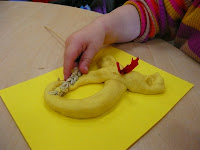Sensory Stimulation Theory
Traditional sensory stimulation theory has as its basic
premise that effective learning occurs when the senses are stimulated
(Laird, 1985).
Laird quotes research that found that the vast majority
of knowledge held by adults (75%) is learned through seeing.
Hearing is
the next most effective (about 13%) and the other senses - touch, smell
and taste account for 12% of what we know.
By stimulating the senses,
especially the visual sense, learning can be enhanced.
However, this
theory says that if multi-senses are stimulated, greater learning takes
place.
Stimulation through the senses is achieved through a greater
variety of colours, volume levels, strong statements, facts presented
visually, use of a variety of techniques and media.
Why use art to stimulate the senses?
People may experience deficits in one or several sensory areas; the
most often observed is visual processing, auditory processing, and
“tactile defensiveness” (an aversion to certain textures and touching).
Creating art with an experienced provider can often break through these
issues in a fun and non-threatening way; enabling the people to
experience new and creative expression.
Sensory art
sessions allow people to have the opportunity to respond to the process
of making and exploring using a wide variety of materials. Sponge Tree
encourage the use of natural materials with in our sensory art
sessions and training.
Sponge Tree can provide sensory art workshops at your children's centres, nurseries, pre schools, schools, colleges, nursing homes, hospitals, community centres, care homes and organisations.
Please contact us for more information


















No comments:
Post a Comment